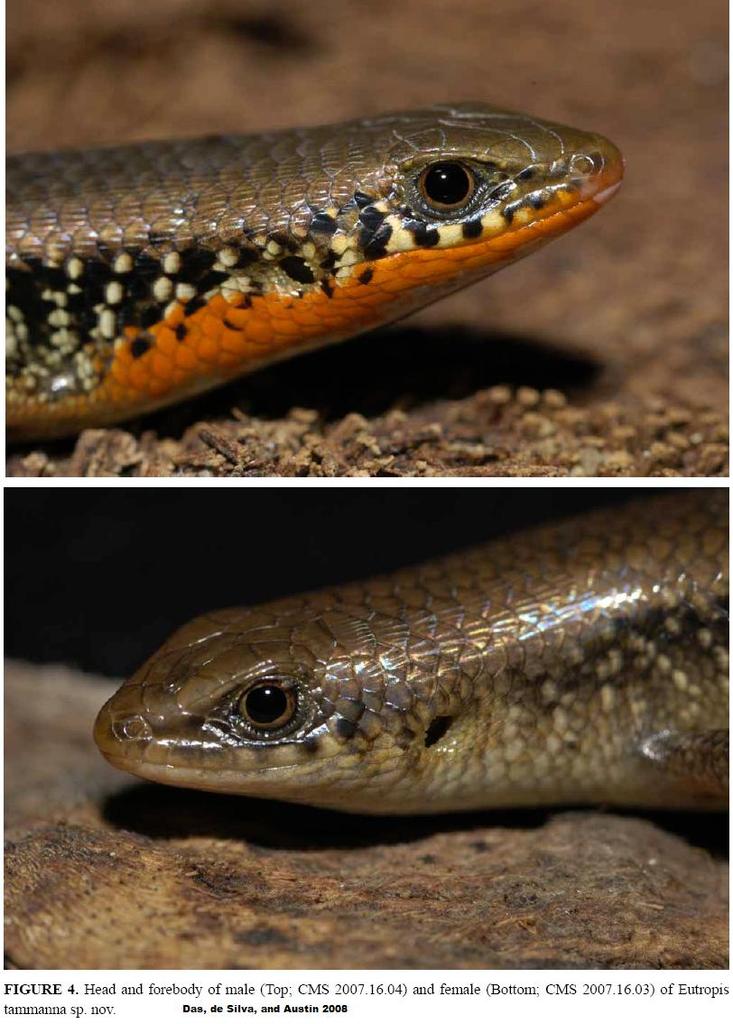
June 7, 2008

Eutropis tammanna (Scincomorpha: Scincidae)
Birder, herper, evolutionary biologist, naturalist Nicholas Sly of Cornell University, Ithaca, New York, asked himself a question many of us here often ask ourselves. How many new animals have been discovered recently?
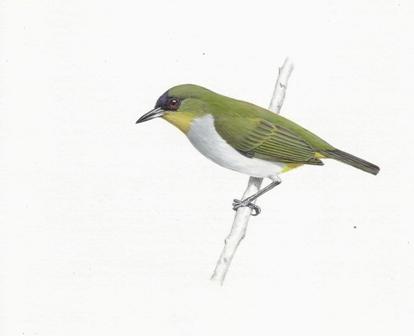
The only new bird described, to date, in 2008? Zosterops somadikartai (Passeriformes: Zosteropidae)
Nick Sly set out to do a little research project to come up with an answer, at least for a small sample. He restricted himself to a manageable goal: only vertebrates, only species that are newly discovered taxa – no splitting of previously known taxa, and only new descriptions for the first five months of 2008.
Sly’s review of the literature was massive. He consulted over 157 issues of 60 plus journals, and compiled a list of 130 fish, amphibians, mammals, reptiles, and birds described so far this year. His “Biological Ramblings” on June 6, 2008, details the incredible list he gathered. His research methodology was exhaustive enough to deliver a good overview answer to his question.
His results allowed him some insights into other inquiries. (BTW, read what I had to say earlier here, about the difference between noting the year of initial discovery versus the year of first description.)
Where are these new animals being discovered?
Nick Sly breaks down the locations, thusly.
For 54 land taxa, here is the range breakdown:
Argentina 2
Bolivia 1
Brazil 5
Chile 1
China 3
Congo 2
Cuba 1
Ghana 1
India 1
Indonesia – Sulawesi 2
Madagascar 2
Malaysia 5
Mexico 1
New Caledonia 1
Panama 2
Peru 11
Sri Lanka 1
Taiwan 2
Tanzania 1
Thailand 1
USA 1
Vietnam 6
Yemen 1
Sly notes: “Peru is the big winner here, with fully 20% of the new land taxa described.”
Looking at the watery discoveries, Nick Sly compiled these analyses:
For the fish, 72 taxa broke down into 38 freshwater species and 34 marine species. The freshwater species were distributed as follows:
Argentina 1
Belize 1
Borneo 1
Brazil 11
Central America 1
China 7
Guyana 1
India 1
Lake Tanganyika 2
Mexico 1
Montenegro 1
Nicaragua 3
Sumatra 2
Suriname 1
USA 1
Venezuela 3
The marine species break down as:
Antarctica 1
Australia 5
Baffin Bay 1
China 1
Indian Ocean 1
Indonesia 1
Indo-Pacific 14
Japan 2
New Caledonia 1
North Atlantic 1
Philippines 1
Red Sea 1
Sao Tome 1
Suriname 1
Thailand 1
Vietnam 1
The data lumped into continents (excluding the marine taxa) comes out this way:
Europe – 1
North America – 2
Australia – 7
Africa – 9
Asia – 41
Neotropics – 49
Nick Sly writes: “It’s remarkable that new vertebrates are still found at all in North America and Europe, but they are. In North America, a new species of darter of the genus Crystallaria was discovered in West Virginia. A frog of the genus Pseudacris was described from the Southeast US. This taxa barely made the list, and probably qualifies as a split rather than a whole new taxa….In Europe, a goby in the genus Pomatoschistus was described from the Balkans.”
Another breakdown shared by Sly, “for simplicity’s sake,…into these five ‘classic’ classes. Don’t berate me about paraphyletic taxa, please…”
Fish – 74 (56.9%)
Amphibian – 20 (15.4%)
Mammal – 6 (4.6%)
Reptile – 29 (22.3 %)
Bird – 1 (0.8%)
Read Sly’s blog for more on his detailed look at the disparity in distribution of new species descriptions versus the relative diversity of these different groups. He found, in summary, that birds and to a lesser extent, mammals were underrepresented in new species discoveries. He feels this may be related to the ease of observing and identifying them, and that they already are two groups of well-described animals. Nevertheless, many new mammals are being found.
I won’t spoil the fun read of digesting Sly’s whole blog by going through all the new vertebrates he found described (read it here). He gives good reviews of the animals, especially of the herps.
I do want to overview the mammals a bit, as they are my favorites.
“Of all of the five groups of vertebrates, I know least about mammals,” Nick Sly writes. Mammals are the animals I’ve studied the most. Therefore, let’s look a bit more closely at what he found among that group.
Sly notes: “Only six new species of mammals have been described this year. I was expecting a few more, especially given that the diverse and cryptic groups Rodentia and Chiroptera (bats) surely have many more species to give. Four of the six new species were indeed from those two groups.”
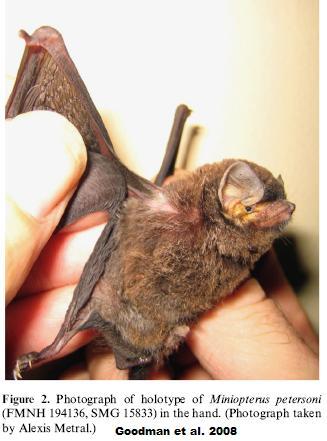
Miniopterus petersoni (Chiroptera: Miniopteridae)
He found that: “Two bats and two nondescript mice are complemented by a new species of possum from Peru, and [a] large new species of sengi, or elephant-shrew, [that] was captured on film by camera traps in Tanzania, and was subsequently tracked down and described.”
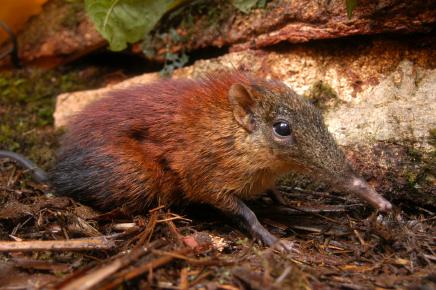
Rhynchocyon udzungwensis (Macroscelidae: Macroscelididae)
Sly shares his list of every species he found newly described. Here is his list of Mammals:
Mammalia
Chiroptera
Miniopteridae
Miniopterus petersoni
Vespertilionidae
Tylonycteris pygmaeus
Didelphimorpha
Didelphidae
Philander olrogi
Macroscelidea
Macroscelididae
Rhynchocyon udzungwensis
Rodentia
Cricetidae
Eligmodontia typus
Muridae
Hylomyscus walterverheyeni
There may be other mammals to add to his list. The greater dwarf cloud rat (Carpomys melanurus) was announced during early 2008, from the Philippines (but perhaps the paper was published earlier?).

Carpomys melanurus
In February 2008, according to the Henry Doorly Zoo’s Center for Conservation and Research, two new species of lemurs were identified in Madagascar. The Scott’s sportive lemur (Lepilemur scottorum) is an agile animal with grayish brown fur and a black-tipped tail. The second new lemur is the Moore’s woolly lemur (Avahi mooreorum), which has brown-gray fur and a reddish tail. (Again, perhaps the paper on them appeared in late 2007?)
Despite his main interest being ornithology, Nick Sly is a passionate herper, so he does pay great attention to reptiles and amphibians, quite understandably. Some of his reproduced photographs of those new herp finds clearly show the attractive nature of these animals, as with the one I have at the head of this posting. And of Cyrtodactylus wallacei (Gekkota: Gekkonidae), the new gecko shown below.
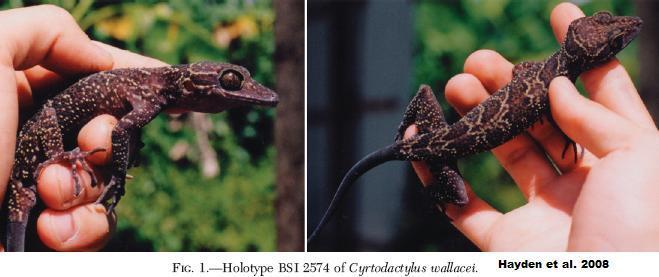
My congratulations to Nick Sly (below) for this remarkable piece of research. Good work!

About Loren Coleman
Loren Coleman is one of the world’s leading cryptozoologists, some say “the” leading living cryptozoologist. Certainly, he is acknowledged as the current living American researcher and writer who has most popularized cryptozoology in the late 20th and early 21st centuries.
Starting his fieldwork and investigations in 1960, after traveling and trekking extensively in pursuit of cryptozoological mysteries, Coleman began writing to share his experiences in 1969. An honorary member of Ivan T. Sanderson’s Society for the Investigation of the Unexplained in the 1970s, Coleman has been bestowed with similar honorary memberships of the North Idaho College Cryptozoology Club in 1983, and in subsequent years, that of the British Columbia Scientific Cryptozoology Club, CryptoSafari International, and other international organizations. He was also a Life Member and Benefactor of the International Society of Cryptozoology (now-defunct).
Loren Coleman’s daily blog, as a member of the Cryptomundo Team, served as an ongoing avenue of communication for the ever-growing body of cryptozoo news from 2005 through 2013. He returned as an infrequent contributor beginning Halloween week of 2015.
Coleman is the founder in 2003, and current director of the International Cryptozoology Museum in Portland, Maine.
Filed under Breaking News, Cryptotourism, CryptoZoo News, Cryptozoologists, Cryptozoology, New Species, Reviews